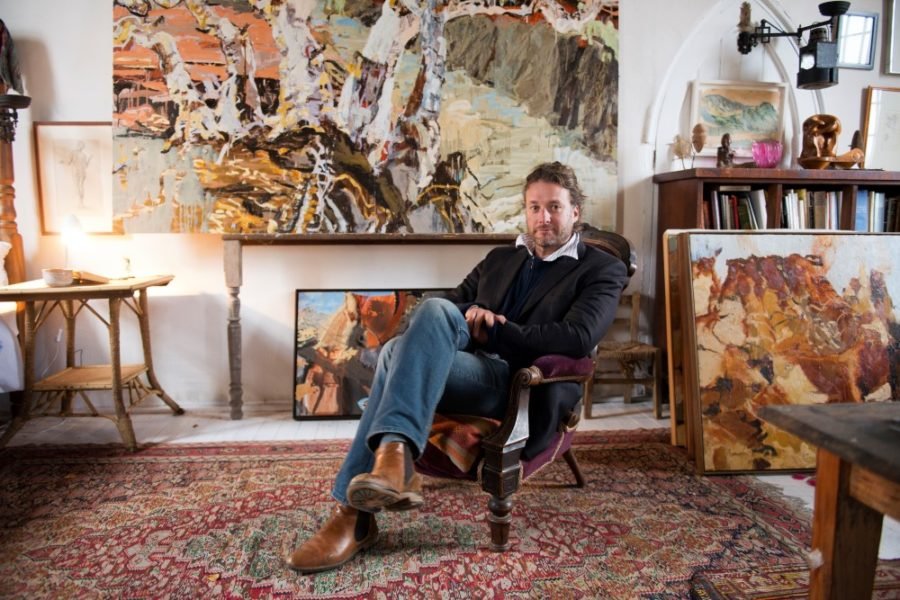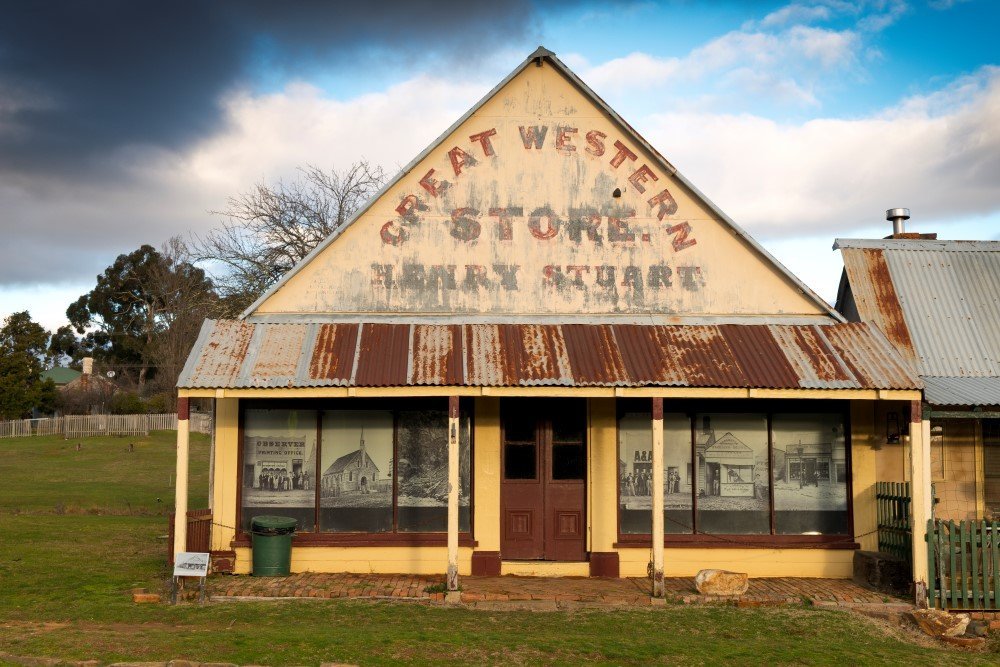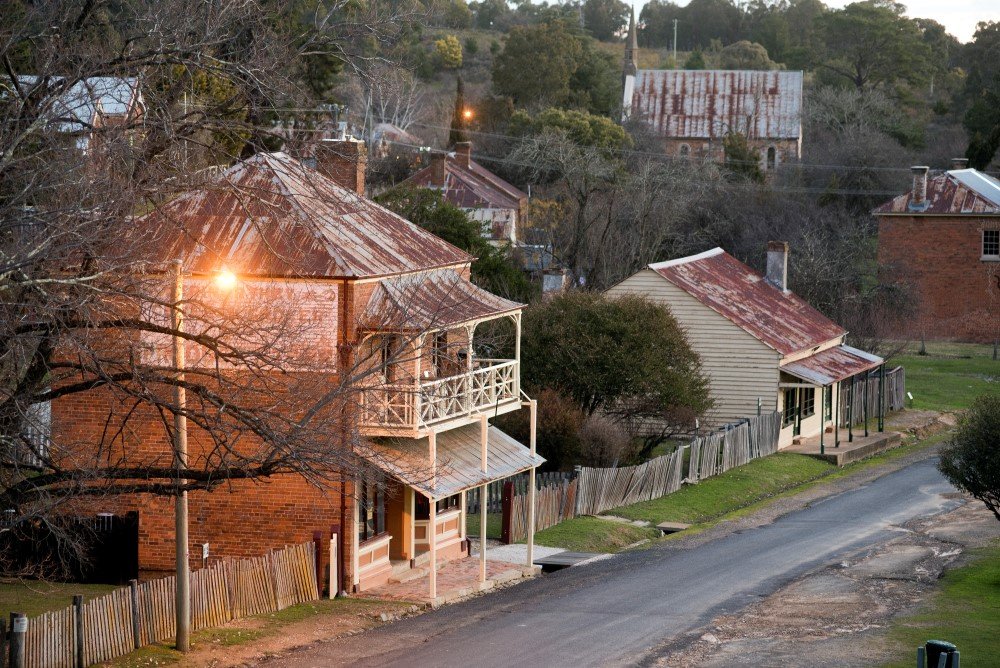Art of gold: Hill End, NSW

A LONG AVENUE OF shady plane trees is an elegant introduction to Hill End. It feels European, a strange diversion from the world of jagged rocks and yellowed grass you pass through to get here. We’re only 190km north-west of Sydney, yet it feels much further.
Aside from the calls of a few distant king parrots, the silence in the town – even at midday – is nearly complete. But Hill End wasn’t always so quiet. In 1872 the town became the largest inland settlement in NSW, after German prospector Bernhardt Holtermann discovered a 286kg gold mass in Hawkins Hill, on the edge of town. The largest sample of reef gold ever found, Holtermann’s huge specimen attracted fortune hunters from Europe, the USA and Australia to the then small town.
The influx of tens of thousands to Hill End and its surrounds turned the town into a thriving settlement, complete with 28 hotels, a stock exchange, an opium den and an oyster bar. They hadn’t come in vain; Hill End became home to what was thought to be the richest quarter mile in the world. Quartz veins thick with gold were followed up to 600m across, and alluvial gold initially seemed easy pickings for miners heading to the banks of the Turon River.
Now, only a smattering of locals sit in the fading sun outside the last remaining pub, The Royal Hotel. Erected in 1872, its walls would have once been privy to the raucous celebrations of miners. But those heady years were short lived. Just two years later, the major mines closed down and those who stayed were hunting for alluvial gold or working in old reefs. At the turn of the century, only 500 people remained, hanging on by panning for gold and living off the land.

Built in 1872, Hill End’s Great Western Store once sold an array of goods to a settlement far from Sydney, but now houses a display of photographs from the Holtermann Collection. (Image: Don Fuchs / Australian Geographic)
By 1947 the town had been all but forgotten, when an article appeared in the Sydney Morning Herald. Sydney-born artist Donald Friend spotted the piece, reading “the country is pitted with diggings that twist and burrow like the trenches of some old battlefield”. He was intrigued, and convinced his friend, painter Russell Drysdale, to drive the untamed roads west.
They were both enamoured by the decaying town and its neighbour Sofala, 25km to the east, with Russell working on emotionally charged landscapes with a frenzied energy. Donald’s was a slower process of art-making – but it was he who bought a cottage in the town that same year. He lived there with his partner, Donald Murray, for whom the cottage is now named.
Other painters soon followed, lured by the richness of the history and landscape and by the unique Australia they saw in their colleagues’ work. By the late 1950s Hill End was revered as a central force in Australian art, with John Olsen, Brett Whiteley, Jean Bellette, Margaret Olley and John Firth-Smith all making the pilgrimage west.
TODAY, THE CONTEMPORARY art scene in Hill End is just as strong. Luke Sciberras, an acclaimed Australian landscape painter who has lived in the village for more than a decade, attributes this to a “tremendous momentum that has been found here”. The list of artists he cites as regular visitors to Hill End sounds like a roll-call of some of Australia’s best contemporary painters: Euan Macleod, Guy Maestri, Ben Quilty and Laura Jones, to name a few.
Luke moved to Hill End in 2002, and, as a young artist, found in it something of a muse. Now, however, Hill End has become something else: home.
“I feel as though I know it very intimately,” he says, adding that living there inspires him, even when he is painting a different place. “Even if it’s not a painting about Hill End, it’s a sensibility and a process I’m connecting to as a landscape painter.” Luke also enjoys the strong sense of community here. “It’s the melting-pot factor that everyone really enjoys,” he says.

The streets of Hill End are quiet in the evenings, though when these buildings were first erected the town was deafened by the din of stamper batteries. (Image: Don Fuchs / Australian Geographic)
And he’s right – when we visit The Royal Hotel that Saturday night we meet everyone from a CEO to a bunch of shearers dirty from a day in the shed. Pete Sparks, the manager, seems to be in front of the bar as often as behind it, pulling beers and cracking jokes in equal measure. Pete tells me he came to the town in 2011 to help a mate build a shed, but when he was offered a job at The Royal decided to stay.
Hill End seems full of people who came with no plans to stay. Speaking in a quiet, lilting voice that’s hard to reconcile with the Wicked Women she has painted, artist Rosemary Valadon tells us that, during a one-month residency in 2003, she became transfixed by Hill End. “I think it was the history of the place,” she says, “the feeling that this is the end of the road.”
The residency was one of two run by Bathurst Regional Art Gallery (BRAG) in the town. Started in 1995, the placements have meant hundreds of artists from all over the world have lived here, even if for just a short while. Artists will often come back to visit, but Rosemary went one step further and made Hill End her home in 2005.
Her recent series, Four Seasons, is a lush, sensuous portrayal of the town’s produce, which she grew herself. From her studio, you can see her thriving vegetable garden, an old kangaroo resting in the sunshine beside it.
Not far from Rosemary’s home, the village falls away, and the ruined surrounds take over. For those wishing to explore on foot, there’s the 4km Bald Hill track. The walk weaves over landscape that rises and falls unpredictably, but it’s easy to follow – the red soil is laid bare, shining bright beside gums that rise like bleached bones.
As we walk, I’m reminded of something Luke said of the land here. “[The miners] reached into the depths of this geology and pulled it all out, like a giant hand going into a lolly jar.” Surrounded by blossoming wattles and watched by ever-present roos, it feels like the land is slowly getting its own back.
At the end of the track is Bald Hill Mine, an 80m passage into the hill that was found to be as bald within as without. “Fickle geography,” says Eddie Long with a laugh. An ex-miner, he now runs tours through the passage. “Initially they thought Bald Hill may have been an extinct volcano and they thought they were gonna go right into the centre of the hill and find diamonds.” Unfortunately, he adds, they did not.
BUT GOLD IN HILL END is not just history. The lure of the precious metal, and those who can find it, carries on. Dave Thomson, a fifth-generation Hill End resident, is one local who carries the golden mantle. “Dave’s a gold magnet, I reckon,” says Rebecca Wilson, his wife and a painter. “It’s the thrill of the chase and where the chase leads you,” Dave says.
The chase has led Dave, who began working in the mines at 14, all over Australia as a prospector. The table in front of us is strewn with the gold he has found; some pieces are like finely wrought jewellery, etched with acid from the quartz they were found in. Others are solid nuggets, surprisingly heavy in my hand. Each of them represents a story to Dave.

Dave Thomson’s life is tied to Hill End – he was married at Kissing Point, with rings forged from the yellow gold of the hills where his family has lived for more than a century. (Image: Don Fuchs / Australian Geographic)
“This one,” he says, holding up a piece to the light, “I found when I was smashed as a crab in the Western Australian desert.”
Now, although he still prospects, Dave also works with timber, and he and Rebecca have just planted their first garlic crop. The pair hopes to expand their harvest next year, and sell the organic garlic to local grocers. That is if their sheep – which scrape the ground up to eat the cloves if left unwatched – don’t get to it first.
Being a jack-of-all-trades seems to be a trademark of the townspeople. Chris Grossett, the principal at Hill End Public School, also prospects in his spare time. In the crisp morning air he talks us through the process of hunting for gold with his detector, a weighty model that set him back more than $6000. Although it makes things far easier, the machine isn’t fail-safe.
“Of every few hundred signals, probably 99 are a nail or something,” he says. He’s found a coin from 1806, belt buckles and musket balls. “If I don’t find something it doesn’t matter,” he says with a smile. “I just set up a billy and relax.”
But hunting for gold wasn’t always such an enjoyable pursuit. Not far from the town is Tambaroora Cemetery – a reminder of those who came to Hill End and found only early graves.

The tombstones of Tambaroora Cemetery give a tragic insight into the lives and deaths of early miners and their families. (Image: Don Fuchs / Australian Geographic)
The headstones often tell the same story. “Killed through carelessness” or “Accidentally killed” are engraved in stone, alongside details of the miner.
Some miners couldn’t afford headstones, and most mounds are marked by simple, nameless white crosses. But many of Hill End’s past residents are immortalised in another way. The Holtermann Collection – some 3500 glass-plate negatives – shows the ordinary people of gold rush towns, including those of Hill End.
The images (see previous spread) are the result of Bernhardt Holtermann’s patronage of photographers Beaufoy Merlin and Charles Bayliss, whom he employed to capture the gold rush. Holtermann’s generous decision to fund the collection came after Merlin and Bayliss photographed him with the gigantic gold mass.
The resulting photos of Hill End reveal incredible insight, showing the residents of wattle-and-daub cottages outside their homes, large mines and stamper batteries, and the throng and excitement in the streets. The photographic process was slow, requiring long exposures and moveable dark rooms taken around in carts – but the enchanting light and detail of the images has since been celebrated by UNESCO’s Australian Memory
of the World register.
Today, glass-plate photos are still being taken in Hill End, albeit with a few more conveniences than in times past. Bill Moseley, a photographer who lives in the town, is passionate about antiquarian photography and has taken glass plates of locals such as Luke, as well as of the town and surrounds. He also runs Hill End Press with his partner, artist Genevieve Carroll, and runs glass-plate workshops.
When they moved to Hill End in 2005 it was to live “in a country town with like-minded people”, says Genevieve. The home they moved in to was falling apart, but they’ve since turned the collection of low-roofed buildings into charming spaces that celebrate art, much of which was made in town.
THE HOMES OF HILL END are made up of original miners’ cottages that would be unlikely to be still standing without the decision to include the town in National Parks and Wildlife’s remit, and declare it a ‘historic site’ in 1967. That first decision initially meant an injection of money for the town, which allowed some buildings to be restored. However, the second, and ongoing, saviour of these vernacular buildings has been the townspeople themselves.
Like Bill and Genevieve, potter Lino Alvarez has invested a lot in his home. His studio, La Paloma, was set up in 1997 when Lino moved here with his wife, musician Kim Deacon. Initially they worked in the cramped quarters of various cottages, but they have since built a gorgeous high-ceiling studio that allows space for the ‘big-pot’ work that they do. Their renovations – the result of painstaking work and local materials – saw the pottery included in a heritage award Hill End received from the National Trust of Australia in 2004.

Beaufoy Merlin lookout, also known as ‘Merlin’s lookout’, overlooking Hill End, NSW, on a foggy morning. (Image: Don Fuchs / Australian Geographic)
On a brisk morning we visit Lino’s studio, and are put to work gathering wood to build a fire in an old drum chimney. As the room warms up, Lino makes sweet coffees that he serves in tiny ceramic cups of his own creation. As we drink, he tells us of the silence he found deafening when he first arrived. Motioning out the window towards an empty block, he explains that in the 1800s a stamper battery was there. Local legend has it the townspeople were unable to sleep when the stamper batteries stopped, because they were so used to the noise.
Lino knows plenty about the town’s history, but he’s also passionate about its present. “This last 20 years we’ve had this wave of more than 20 artists,” he says. He’s working on a book that features many of the artists who have been connected to Hill End, and tells the intertwined histories of food, pottery and fire.
And it’s because of such creative, passionate locals that the story of Hill End isn’t finished just yet. Their homes – built first as rough miners’ cottages and now enjoying a second life as artists’ studios – are symbolic of a town where the fortunes and riches have moved from below the earth to above it.
READ MORE:
- GALLERY: Hill End, NSW
- Australia’s gold rush in pictures
- Golden glory: Australia’s biggest gold nuggets
- Australia’s top 10 ghost towns

